Review: AppleShare IP 6.1

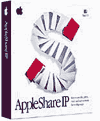 Product Information
Product Information
Published by: Apple Computer, Inc.
Phone: (800) 293-6617
Web: http://www.apple.com/appleshareip
List Price: $999 (50-user license)
System Requirements
Apple Power Macintosh or Apple Workgroup Server
or a 6500 series computer with a 603e processor.
Mac OS 8.1 (Mac OS 8.5 recommended)
48 MB RAM minimum, 75 MB of disk space minimum
A Mac, A Server?
Traditionally speaking the Macintosh has made for a lousy server. Much of this is attributed to the antiquities of the Macintosh operating system, which, in contrast to an operating system such as UNIX, prevents the Mac from performing well as a server. True, solutions such as WebTEN have circumvented the Mac OS and, in the case of WebTEN, yielded better Web serving results on the Power Macintosh than on most any other computer. However, up until recently Apple’s server solution, AppleShare, was inadequate for anything but a small network of Macintosh computers desiring to share files among one another.
AppleShare IP changed all that; upon releasing version 5.0 of the AppleShare server software, Apple renamed the package AppleShare IP and added a lot more than simply a new name. Since then AppleShare IP has seen one major upgrade, to version 6.0, and another minor update to 6.1. Version 6.1 of ASIP is truly remarkable in many ways. In many respects it has smashed Apple’s reputation for being unable to deliver a serious server solution. However, in order for ASIP to be taken seriously by the networking world at large, Apple needs to add some features and fine tune certain elements.
A Jack of All Trades
ASIP is an all-in-one package, which is to say that it provides HTML, SMTP, POP3, IMAP, Finger, NotifyMail, AppleShare (via AppleTalk and TCP/IP), FTP, and Print Server (again, via TCP/IP or AppleTalk), DNS, and Windows File Sharing services...quite an ambitious work load. ASIP ties all of these services together using seven (or eight if you include MacDNS) applications in total: AppleShare IP Manager; Web and File Server, its admin application; Mail Server, its admin application; the Print Server and its admin application. The admin applications provide the administrator with a number of settings for each service. The actual server applications themselves can run as faceless applications (with no windows open) but also offer a number of nice monitoring devices for administrators. Both the server applications and their admin counterparts run as OpenDoc components. I am still not quite sure why this is, and Apple hasn’t said much about ASIP and OpenDoc, but it was interesting to discover that ASIP does require OpenDoc to run.
Setting Up a Server
AppleShare IP 6.1 requires a PowerPC processor, from the 601 up through to the G3. Speaking from my own experience with ASIP, a G3 makes a big difference in performance over even a very fast 604e, particularly for the file server. Most of the other services are not as obviously affected by a faster processor. I ran ASIP on a 240 MHz 604e off of a 60 MHz bus for several months and performance was good, but once I upgraded the server to a G3, performance nearly doubled for file services. Part of this is attributed to the SCSI bus, but Apple has reported that the G3 processor dramatically increases file serving performance, even for comparable SCSI buses, over previous PowerPC chips. ASIP requires 48 MB of RAM with virtual memory, or 64 megabytes of real RAM. Running ASIP with virtual memory on is an incredibly bad idea and will yield sub-par performance. With RAM being so cheap these days, I recommend no less than 128 MB of RAM for an ASIP server.
In terms of setting up the server, ASIP couldn’t possibly make life easier. There is a setup assistant which holds the user’s hand through the process, and in a few moments most anybody can have a server up and running. There are a number of options in the various admin applications which need to be tweaked for a user’s particular setup, but these are very simple and well documented parameters. Generally speaking ASIP gets a perfect ten in the ease-of-use and setup department.
AppleShare File Sharing
Undoubtedly one of the primary reasons an administrator would take interest in ASIP is because of its ability to provide speedy file sharing services. In this arena, not surprisingly, ASIP shines. Not only is AppleShare file sharing fast, but it is easily configurable and well implemented. Even pre-OS 8 users can access HFS+ volumes that are served up by ASIP, which is slick.
Administrators define Share Points, which are the directories or volumes which clients will mount on their desktops as remote volumes. Even removable volumes such as CD-ROMs can be defined a share points, which is cool. I was even able to connect to CD switchers and share all the CDs in these switchers (eleven total) via ASIP (for more information on CD sharing, see http://www.milesapart.com/). Aside from share points, privileges may be assigned to any file or folder on any of the server’s volumes. The administrator can access any file on any of the server’s volumes, but he may restrict access for users and groups as he or she sees fit. The distinction between a Share Point and a restricted item is subtle but important and I particularly like this model of privilege allocation.
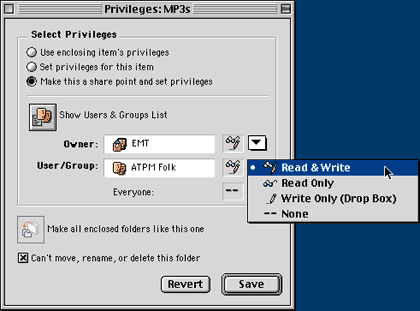
There is a global set of users and groups which are defined in the Web and File Admin application, along with Share Points. Users and Groups are defined for all services, which is to say that there is one central users and groups database, which all the services (mail, FTP, web, AppleShare, etc.) tap into when necessary. This makes administrating the server considerably easier that it could be if a separate FTP and Web server were run on the same machine, for example.
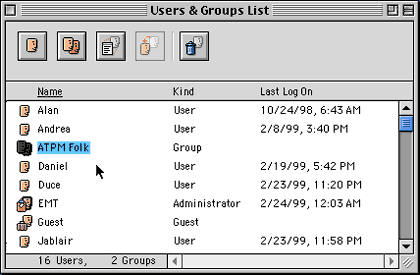
The file server is pretty smart as well. First of all, it always tries to establish the connection between the client and server via TCP/IP, even if the users goes through the Chooser and connects via AppleTalk, because TCP/IP is much faster than AppleTalk. Another nicety: if a user copies a files from one shared volume on an ASIP server to another, the files will be transferred directly on the server itself and will not go through the client. This is, of course, the way it should be, but it’s still very cool that Apple has implemented this functionality.
The file server performs very well, outperforming NT when both the server and clients are running OS 8.5.1, over a 100Base-T TCP/IP network, according to Apple. Generally speaking I found that the performance was excellent, limited only by the SCSI bus of the server itself, over a 200 Mbps full duplexed 100Base-T network. This is to say that purchasing a good SCSI card and a fast drive is essential to truly yield the performance ASIP can provide.
Windows File Sharing support is included in ASIP’s file serving abilities. I was able to test this in a few PCs with both Windows 95 and 98, and it worked quite well. ASIP’s ability to facilitate Windows users is a big selling point and enables ASIP to function as a cross-platform server, particularly because making non-Mac or non-AppleShare servers work with Macs can be an issue.

AppleTalk Multihoming is supported as well. This means that you can stick three Ethernet cards in your server, and use all four Ethernet ports (three plus the internal Ethernet connector) all at once for incoming AppleTalk client access. In other words your server can perform as a router, sort of. Separate branches of the network can be plugged into each Ethernet card and they will all have access to the file server and the print server via AppleTalk. This is a nice feature, particularly because ASIP will even do it for LocalTalk networks, so you can bridge an Ethernet and LocalTalk network via Multihoming; both the LocalTalk and Ethernet branches of the network will have access to the file server, with no additional hardware. Very slick. ASIP supports up to four Multihomed ports in total, Ethernet and/or Localtalk. My only complaint with Multihoming is that the print server doesn’t multihome, it is only accessible to clients connecting through the server’s primary network interface (whatever is chosen under the AppleTalk control panel).
So what’s the verdict on the file server? It gets exceptionally high marks from me. I think it’s the strongest suite in the package. This is hardly surprising considering that AppleShare was originally nothing more than a file server. So Apple has had some time to perfect these services, and I believe that they have done an exceptional job. The only thing I wish the file server provided is logging, particularly for file transfers and user logons/logoffs.
Web Server
ASIP provides a solid Web server as part of its numerous offerings. Apple includes a default Web folder and a handful of cute HTML files to get you started. The path to the Web folder can be changed, as can the name and path of the homepage HTML file. Version 6.1 has added support for multiple domains, so users can setup a server which has multiple Web sites for multiple domains, all served from one machine. Essentially, one achieves this by defining the path to the homepage for each domain.
The performance of the ASIP Web server is on par with WebStar, but honestly I have no hard data to compare its performance to WebStar, WebTen, or NT. Suffice it to say that it is more than adequate for most small or medium sized networks. I can only imagine a large user base connecting over high bandwidth lines bringing the ASIP Web server to its knees. Configuring user access and privileges is slick: just pick a folder, assign privileges to users and groups as you would with the file server. Users will then be presented with an authentication dialog upon attempting to access that directory via a Web browser. Apple has made it a matter of a few mouse clicks to set up drop boxes, read-only directories, and other such restricted directories.
The Web server can execute CGIs and ACGIs, which can be AppleScripts, applications written in C/C++ (or another langauge) which use AppleEvents, or Perl scripts sent out to MacPerl. CGI performance is not stellar for AppleScripts, although OS 8.5.1 does help to speed things up. Making Perl scripts which were written for UNIX work with MacPerl can be a nightmare, but that’s not Apple’s fault. Generally speaking Apple has provided an open-ended Web server. WebStar API-compatible plug-ins can be used, and it is easy enough to link up to FileMaker using Lasso or some other solution.
One cool thing Apple has included is the Upload CGI, which enables a Web users to upload files to the server from their browser. It’s very snazzy and easy to implement.
Without question, the coolest feature the Web server provides for is remote administration. An administrator can carry out almost every function and tweak nearly every server setting from most any Web browser. It’s a very nice feature that some of the virtual servers I have dealt with in the past have offered.
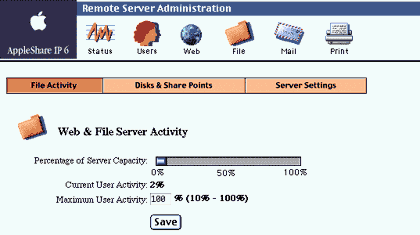
Overall the Web server is solid, but it could be better. For example, there is no support for server side includes at all. This is entirely lame on Apple’s part. Also, Apple provides no CGIs to deal with form input or even the most basic interactive Web site tasks. How hard would it be for Apple to put together a simple CGI to mail out form data from a Web form through the ASIP mail server? I bet it would take them a lot less time than it would take me, or your average ASIP administrator. There is very limited logging as well. There are logs but they don’t offer all of the tracking and statistical breakdowns I would like to see.
FTP Services
Also included in the Web and file serving package is an FTP server. There are no settings for this server, although greeting messages can be customized for FTP users. Providing for FTP access is helpful in many respects. First of all, for low bandwidth connections (such as an analog modem) users will experience snappier responses via FTP than they will via AppleShare. The reasons for this are fairly obvious. For example, via AppleShare the operating system must download icons and other directory information every time a folder is opened, whereas via FTP this is not an issue. Also, while ASIP does offer Windows File Sharing support, often times FTP is the easiest way to deal with cross platform file transfers, and certainly is the easiest way to support an otherwise unsupported operating system such as BeOS or OS/2, neither of which would be able to mount an AppleShare volume directly.
The FTP server does provide for some logging, and generally speaking it is adequate. I wouldn’t mind being able to configure things a bit differently. For example I would like to have a specific directory dedicated to anonymous FTP users, and another directory for registered users. However ASIP doesn’t really provide for this. Or more accurately, it does provide for these settings, but they must mirror the AppleShare file server settings exactly. There are no independent settings for FTP. It might be nice to set things up a bit differently for FTP users from time to time.
Going Postal
AppleShare IP also offers a mail server, complete with POP3, IMAP, PASS, APOP, Finger, NotifyMail and SMTP support. Most of my experience with the mail server is with POP3 and SMTP, but from what I have heard and seen, IMAP support is well implemented. The POP3 support is solid, and provides for APOP support, which is very nice. The SMTP server is brisk and has worked very well for me. At present I use it exclusively for all my outgoing mail, particularly because my local ISP imposes a strict limit on attachment sizes, which can be a real pain. Furthermore, I run a listserv on another machine on my LAN, and my local ISP would yell at me for the traffic with which I would be flooding their SMTP server.
All in all I have found the mail server very reliable, fast, and extremely useful. All POP/IMAP accounts for the mail server are generated through the Users and Groups console in the Web and File Admin application. A user can be set to POP3, IMAP, or both, the latter of the three options providing for the most flexibility. ASIP offers the option of using an alias for e-mail addresses, such that the user with logon name Evan might have the e-mail address etrent@mydomain.com rather than Evan@mydomain.com. I imagine this might prove useful for folks who like to log onto servers with the handle Slothman but don’t want their boss to get upset when people are e-mailing Slothman@motivation.com for info on the latest set of motivational seminars.
A feature I was surprised to find implemented in ASIP’s mail server is support of NotifyMail. Administrators can switch NotifyMail on selectively for any user. For those readers unfamiliar with NotifyMail, it is an extension which listens on a specific TCP/IP port for new mail and when new mail arrives the user is alerted in some fashion. NotifyMail is very cool because it will talk to a number of popular e-mail clients and tell them to get mail when new mail has arrived, which means that you need not set your e-mail client to check every five minutes, which can hog your CPU and slow down your net connection intermittently. NotifyMail is intended for use with full time Internet connections, not dial up connections. For full time Internet access NotifyMail can be truly useful; for readers who wish to read more please see: http://www.notifymail.com/Products/NotifyMail/notifymail.html
ASIP’s mail server also provides for some nice anti-spamming features, as well as a fairly sophisticated set of SMTP parameters for dealing with various hosts. For example, messages can be relayed through hosts, blocked from hosts, allowed from hosts only if they are for local recipients (i.e. prevent relaying through your mail server), or all messages from a host can be blind carbon copied to an e-mail address. There are other options as well, and Apple plans to implement even more anti-spamming options in the future, so I’ve heard.
The mail server also has an option which allows the administrator to set all of a user’s incoming mail to forward to a specified address, which can come in handy for temporary situations, or simply for aliasing purposes.
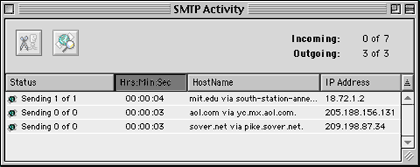
Overall the mail server is very good. It has most of the features needed, is zippy but not overwhelmingly so, and provides for a number of protocols, including the elusive IMAP, the somewhat obscure (but very cool) NotifyMail, and APOP encryption for POP3. As with the rest of ASIP, logging could be better, but it is decent. Status displays are snazzy and provide for good monitoring of server activity. The mail server is certainly the second strongest suite in this package, taking a close second behind the AppleShare file server.
The Print Server
Without question the weakest link in AppleShare IP’s chain is the print server. For small networks and classroom environments, the print server will be more than adequate. I have experienced good response time from the server, and it works well with all the printers with which I have tested it.
The print server worked well for me printing to both printers connected via TCP/IP and AppleTalk, and I was able to print from client machines to the ASIP print server using both TCP/IP and AppleTalk. A nicety that Apple provides is the ability to remove a printer from the Chooser’s display, which prevents clients from printing to these printers directly, forcing them to go through the print server. ASIP will also print cover pages before, or after, documents which are printed through the print server.
On a less positive note, I have read on the AppleShare IP listserv that many other customers are having serious problems getting the print server to work with printers, particularly with Tektronix color printers and a handful of other less mainstream printers. One complaint most every ASIP user has is that the print server supports password protected printing but Apple’s LaserWriter 8.5 driver still doesn’t support printing to a password protected printer! Apple claims that a new version of LaserWriter 8.5 is under development and will be released any day now.
MacDNS
ASIP also includes MacDNS, which provides for bare bones DNS services. MacDNS is not as slick as QuickDNS from Mice and Men http://www.quickdns.com/ and it still isn’t PowerPC native, but it’s free and provides basic DNS serving. It would be nice if Apple would update this dinosaur, but for many users MacDNS will prove adequate. For the rest of us, there’s QuickDNS.
Administering the Server
AppleShare IP provides for a limited suite of administrative functions while the server is running. The mail, Web and file, and print servers all have Admin applications which enable the administrator to configure the server, and also provide for some status displays of various sorts. Messages may be broadcast to individual AppleShare clients, users may be booted off of the server, activity of the various server suites may be monitored, and print server jobs may be held, moved from queue to queue, or cancelled altogether.
I found that, generally speaking, it would be relatively unwise to attempt to run any other full time applications at the same time as AppleShare IP. This is to say that ASIP really is intended for use on a dedicated server, as are most server packages.
One of the niceties of ASIP is that an AppleShare client, with the proper privileges, can modify access privileges for files and folders on the server. This means that I can administer the file server from the desktop of my main computer, rather than going over the server, which is nice. This is easily done through the Get Info dialog, by way of the Sharing menu item in the pop-up menu which defaults to General Information.
The Wish List
AppleShare IP is such a great product. However I have some complaints, and a small list of features I wish were implemented.
On the complaint side, ASIP currently has a RAM bug. The problem occurs because ASIP does not use RAM allocations, rather it uses the System heap. The administrator tells ASIP how much RAM to leave free, rather than how much RAM to use. However, many users have experienced instances where ASIP uses all available RAM regardless of the amount they indicated they wished to have left free. I personally never experienced this bug once, however an overwhelming number of users on the ASIP listserv have complained about this bug. Literally as I started to write this paragraph, I received an e-mail from the listserv indicating that ASIP 6.1.1 had been released, and that the RAM bug had been fixed.
The other primary complaint I here about is the problems administrators experience with the print server. Not knowing first hand what their problems are, I can only speak, again, from what I have read on the ASIP listserv. As with the RAM bug, a large group of users seem to find the print server either inadequate, or problematic.
There is also a Sherlock bug, which prevents clients from indexing mounted volumes which are anything but entire server volumes. In other words, if the administrator has decided to share a directory on a volume rather than the entire volume itself, Sherlock will not index properly when the client mounts this shared folder. Apple has promised to fix this for the next release of ASIP.
In terms of minor little gripes which I personally have with ASIP, there is the issue of logging for both the Web and file server, which is completely inadequate. There is also the issue of aliases pointing to IP addresses for TCP/IP ASIP servers, rather than to domain names, which can be an issue if the DNS server which assigns the domain name an IP address assigns them on a dynamic basis rather than a static one.
As far as the wish list goes, I wish that the AppleShare client provided for some sort of chat engine, so that the admin and a client could chat, or even a client and another client, logged onto the same server, could chat. This functionality can be achieved by installing Apple Network Assistant on both the client and server, but it would be nice if ASIP included this functionality as part of the client and server package.
I would also like to see some settings for the FTP server, specifically for setting up separate paths and parameters for anonymous FTP users. I definitely would like the see the functionality of the Web server increased. As it is now it provides only a bare bones Web server, and frankly it just doesn’t cut the mustard. I want server side include and some prepackaged CGIs. The multi-domain provisions are nice, as is the awesome remote admin CGI; both are an indication that Apple can utilize the plug in architecture to greatly enhance the facilities of the Web server, and I wish they would do so to a greater extent.
I wouldn’t mind seeing an update to MacDNS, even if it was just a recompilation into PPC native code. Apple used to bundle Vicom Internet Gateway with ASIP 5.0, but they stopped with 6.0, which is too bad because VIG is a very useful application and I could certainly see how most ASIP users would find it valuable.
Overall Impressions
These petty grievances aside, ASIP is awesome. It is an all-in-one server solution that shines in the file serving arena, offers a very nice mail server, provides solid FTP serving, decent Web serving, and an OK print server. Overall as an integrated suite I would certainly say that ASIP is a good value at $999 for a 50 users license; and for schools, small, and medium sized networks, it seems like a perfect solution. For larger, more complex networks, it is less appropriate, but still worth a serious look. Future releases of ASIP promise even more finesse and features than the current incarnation.
ASIP never crashed on me, and I ran it for months without a hitch. I find the user interface as welcoming as one would expect from Apple, the performance excellent, and the feature set impressive. There is an incredibly flat learning curve, and the support Apple provides on its listserv is excellent.
The bottom line? If you have a small or medium sized network of Macs, PCs, or both, ASIP may be your best option of you need a jack of all trades server package, or even if you won’t use all of ASIP’s suites but want one or two of them. However, if you want the best Web server on the market, or the best print server, look elsewhere. Similarly, if you are running an ISP or an industrial strength network, ASIP may not be quite sufficient, but I would encourage you to look at it anyway, as it may serve some of your purposes quite well and can make administrative tasks much less painful. I would encourage readers who are interested in ASIP, its capabilities, limitations and specifications, to visit Apple’s AppleShare IP Web page at http://www.apple.com/appleshareip/.
To summarize: ASIP is an extremely impressive product, perhaps one of Apple’s greatest accomplishments in a long time. With a mere handful of quirks, it is well on its way to becoming a genuine contender in the world of networking.
![]() Copyright © 1999 Evan Trent, etrent@atpm.com. Reviewing in ATPM
is open to anyone. Contact reviews@atpm.com for more information.
Copyright © 1999 Evan Trent, etrent@atpm.com. Reviewing in ATPM
is open to anyone. Contact reviews@atpm.com for more information.
Reader Comments (0)
Add A Comment